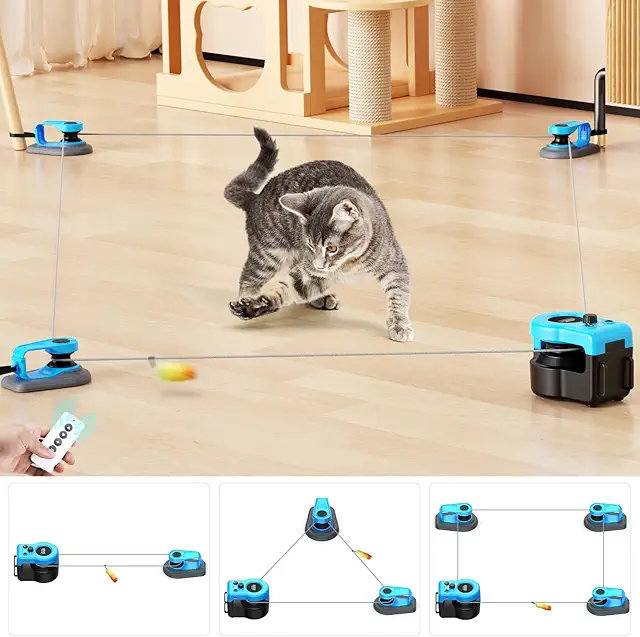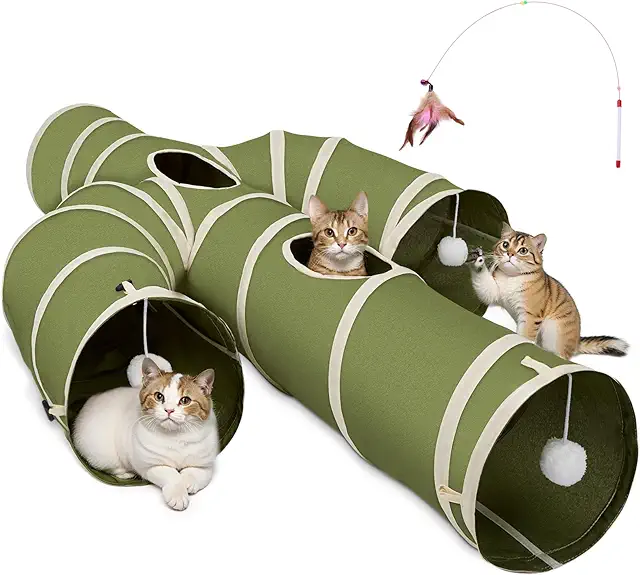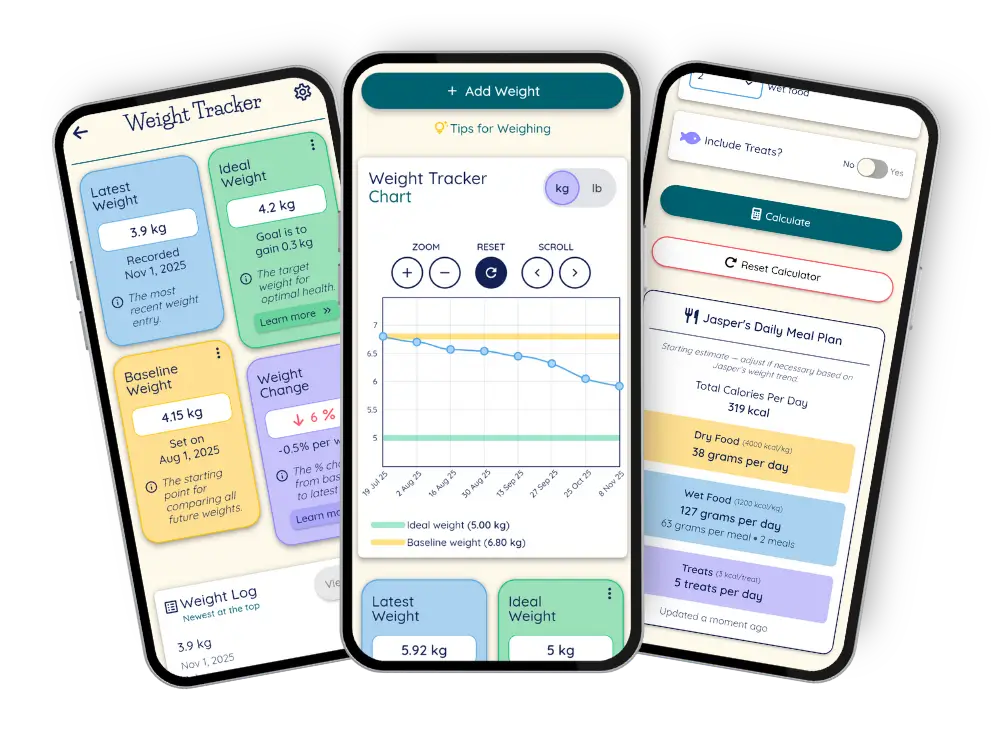How to Prevent Cat Obesity | 10 Ways to Keep Your Cat Slim
Updated

Introduction
Obesity in cats is the most commonly diagnosed feline nutritional disorder. The latest figures suggest an estimated 60% of cats in the USA (Pet Obesity Prevention), 53% of cats in the UK (PDSA), and 32% of cats in Australia (Australian Veterinary Practitioner) are overweight or obese.
Unfortunately, the number of overweight and obese cats has increased over the years, but as with all diseases, prevention is better than cure. By carefully monitoring our cats weights and being aware of how much and what they are eating, we can prevent excessive weight gain, and hopefully, the feline obesity trend can be slowed down and even reversed.
In this article on how to prevent cat obesity, you will discover the following:
- What kitten growth charts are and how to use them
- How to monitor your cat's weight and body condition score at home
- Why it's important to adjust your cat's diet once spayed/neutered
- Our awesome cat food calculator to help estimate how much to feed
- If it's better to use digital scales or a cup to measure your cat's food
- How to calculate how many treats to feed and our top pick low-calorie treats
- Our favorite puzzle feeders to make cats work for their food
- Fun ways to encourage daily exercise
- How to prevent a cat from stealing another's food
Why It's Important to Prevent Feline Obesity
Obese cats are at an increased risk of multiple health issues that can be caused by obesity or worsen due to obesity. Not only is preventing obesity important for your cat's quality and length of life, but many overweight cat health problems are expensive to manage and treat. For more information, read 12 Obese Cat Health Risks.

1. Kitten Growth Charts
Preventing cat obesity starts from kittenhood. Waltham Petcare Science Institute has created evidence-based growth charts that can be used to check your kitten is following normal healthy growth. Never rely only on growth charts and always consult your vet to ensure your kitten's weight is appropriate.
Plotting growth charts requires you to know your kitten's age in weeks, so if you are unsure, use our calculator below:
Kitten growth chart instructions:
- From 8 weeks of age (or as soon as possible), weigh your kitten every 2-4 weeks using accurate and comfortable scales, such as Beurer Digital Pet Scales.
- Find their age (in weeks) on the horizontal axis and weight (in kg) on the vertical axis and make a dot where the lines intersect.
- A kitten's growth should approximately follow one of the curves (centile lines); it doesn't matter which one or if the growth follows between two curves.
- If the growth you are plotting deviates significantly higher than the line they were following (crosses two or more centile lines upwards), your kitten may be at risk of becoming overweight, and the amount of food needs to be decreased. If the growth deviates significantly lower than the line they were following (crosses two or more centile lines downwards), this may indicate they have become underweight, for example, due to underfeeding, intestinal parasites, or an underlying disease.
- Always discuss the results with your veterinarian.
Normal Kitten Growth Charts

Abnormal Kitten Growth Charts

2. Monitor Your Cat's Weight
Aim to keep your cat at the weight they are once they reach maturity, at about 12 months of age, as long as they are their ideal weight and not already overweight. Record their weight monthly with accurate scales, such as the Beurer Digital Pet Scales. If you detect their weight trending upward, you need to reduce the calories they receive.
- Accurate, reliable, and comfortable digital scales
- Easily monitor your cat's weight at home every 2-4 weeks
- Gain valuable information about their health and detect potential issues early on
3. Monitor Your Cat's Body Condition Score
Although checking a cat's weight is important, an ideal weight can vary from 2.5-7 kilos (5.5-15 pounds) depending on the breed and individual. Therefore, body condition scoring is a more reliable way of determining if they are a healthy weight, which involves a visual and hands-on assessment. A 9-point scale is used, with 5/9 being ideal, 1/9 being severely underweight, and 9/9 being severely overweight.
Your cat should ideally be body condition scored at every vet visit. You can also learn the technique by reading How to Body Condition Score Your Cat. Keeping track of your cat's body condition score once a month will help you quickly detect and act upon any increases.

4. Feed Your Cat a Suitable Diet
Your cat's food should be suitable for their life stage. For example, kittens require a diet for growth, whereas adults require a maintenance diet. A gradual switch is made from kitten to adult food when they have finished growing, at around 12 months. Kitten food tends to be more calorie dense, so feeding it to an adult who has finished growing can lead to weight gain.
Consider feeding low-calorie diets, such as Royal Canin Appetite Control, to cats prone to weight gain, for example, if they are spayed/neutered, indoor only, and have low activity levels. Canned food may also help prevent weight gain because the higher water content dilutes the calories.

5. Feed the Correct Amount of Cat Food
An important way to prevent your cat from getting fat is to measure out the correct portion of food for the day. The amount of food required will vary depending on your cat's weight, whether they are spayed/neutered or intact, and their activity levels. Feeding guidelines on the packaging can be used as a starting point. However, these are only estimates and the amount may need to be adjusted based on monthly weight and body condition score checks.
We recommend using the Expert Cat Care Wet and/or Dry Cat Food Calculator to estimate how much to feed your cat based on their body weight and activity level.

Always weigh the food with precise digital scales, such as the Amazon Basics Kitchen Digital Scales. Using cups to measure food is unreliable and can lead to accidental overfeeding. One research study found owners might accidentally feed up to 80% extra food when using a cup.
It's also important to know that every time your cat vocalizes, it doesn't necessarily mean they are hungry and that you need to give them extra food. It's important to consider if they are seeking attention, such as for play or affection, or even if they're distressed.
Amazon Basics Digital Kitchen Scale
- Affordable and reliable digital food scales
- Essential for accurately weighing your cat's food to prevent excessive weight gain
6. Limit Feeding Treats
If you are feeding your cat treats or titbits, these calories need to be accounted for in their daily allowance, meaning you will have to provide less of their main diet. However, treats should not comprise more than 10% of their daily calories to avoid an unbalanced diet and nutritional deficiencies. Find out how many treats you can give your cat a day with our Cat Treat Calculator.

To help keep your cat slim, low-calorie treats can also be offered, or vegetables, such as carrots and courgettes. To show your love and spend bonding time together, consider a grooming, play, or cuddling session, offering catnip, or going on a walk instead of treats.
Recommended Low-Calorie Treats
| Product | Empty | Features | Price |
|---|---|---|---|
 | Hills | Hill's Metabolic Crunchy Cat Treats
| View on Amazon |
 | Greenies | Greenies Tempting Dental Treats
| View on Amazon |
 | Fruitables Cat Treats |
| View on Amazon |
 | DentaLife | Purina DentaLife Dental Treats
| View on Amazon |
7. Decrease the Amount of Food Once Your Cat is Spayed/Neutered
Spayed/neutered (fixed) cats are prone to weight gain due to a reduced metabolic rate, an increased desire to eat, and reduced activity levels. Therefore, the number of calories they consume will need to be reduced by 10-30% once fixed. Continue to monitor their weight and body condition score, and adjust the amount fed accordingly.
There are diets formulated to help maintain a healthy weight after sterilization, such as Royal Canin Appetite Control Spayed/Neutered for adult cats and Royal Canin Spayed/Neutered Kitten for cats less than 12 months of age.
Recommended Diets for Fixed Cats
| Product | Empty | Features | Price |
|---|---|---|---|
 | Royal Canin Appetite Control |
| View on Amazon |
 | Royal Canin Spayed/Neutered Kitten | Royal Canin Spayed/Neutered Kitten
| View on Amazon |
8. Make Cats Work for Their Food
Use puzzle feeders to slow your cat's eating and increase their feeling of fullness. Puzzle feeders also increase activity and provide enrichment, helping to combat boredom and stress.
Recommended Puzzle Feeders
| Product | Product | Features | Price |
|---|---|---|---|
 | Trixie Activity Fun Board |
| View on Amazon |
 | PetSafe SlimCat |
| View on Amazon |
 | Indoor Hunting Cat Feeder |
| View on Amazon |
 | Lickimat Slow Feeder |
| View on Amazon |
 | Snuffle |
| View on Amazon |
9. Daily Playtime and Exercise to Prevent Obesity
A fifteen-minute play session once a day will help keep your cat healthy and avoid obesity. Use fishing rod-type toys to bring out their inner hunter, like our favorites Da Bird and PurrSuit (UK), which are extremely durable and sound and look like real birds. Interactive, automatic toys, such as the AsFrost Auto Chase Cat Toy, which involves a feather moving at speed around a rope course, are also great ways to keep your cat exercising when you are busy.
Another great way to increase activity is clicker training, which also provides mental stimulation and bonding time. We love the Cat School Clicker Training Kit, which includes everything you need to get started. Just make sure to use low-calorie treats (and reduce the amount of their main food accordingly) or use some of their food allowance for the day as a reward.
Many cats also love going on walks, and you can teach them to walk on a leash and harness, such as the comfortable and hard-to-escape Voyager Harness. If your cat doesn't like going outdoors, or it's unsafe in your area, consider an indoor cat exercise wheel. We love the Star Cat Wheel, which is silent, safe, and durable, and has a moving luminous fish that grabs their attention and encourages them to run.
Fun indoor cat play areas can also be created to encourage daily exercise using large multi-level cat trees, such as the tall and sturdy IMUsee 68 Inch Cat Tree, wall-mounted shelves, such as the beautiful designs by CatastrophiCreations, and fun multi-branched tunnels, such as the Ownpets Cactus Tunnel.
Recommended to Encourage Exercise
| Product | Empty | Features | Price |
|---|---|---|---|
 | 1 | A high-quality and irresistible toy that encourages hunting behavior when swished along the floor and through the air. | View on Amazon |
 | 2 | An exciting feather toy that zooms around a rope track. Adjust the speed, direction, and path to keep it entertaining. | View on Amazon |
 | 3 | Cat School Clicker Training Kit Provide mental and physical stimulation as you teach your cat to fist bump, jump, and weave through your legs! It's a fun and bonding experience. | View on Amazon |
 | 4 | This comfortable and fully adjustable harness is perfect for starting indoors and gradually progressing to the garden, park, and even hikes! | View on Amazon |
 | 5 | Made from high-quality lightweight laminate birch that allows cats to gain momentum easily, and a moving luminous fish that grabs their attention. | View on Amazon |
 | 6 | A tall, sturdy, high-quality, affordable, and easy-to-assemble cat tree that's great for climbing and playing. | View on Amazon |
 | 7 | CatastrophiCreations Furniture Beautifully crafted multi-leveled wall-mounted shelves that are easy to install and an excellent way to encourage activity and exercise. | View on Amazon |
 | 8 | A multi-branching tunnel made from durable fabric that cats love for exploring, playing, and chasing. Hide kibble and play with toys in and around the tunnels to encourage activity. | View on Amazon |
10. Stop Food Stealing Among Cats
If you have multiple cats and one of them eats more than their share, feed them in separate rooms and then remove any food that has not been eaten. Competition for food can also cause overeating, as one cat may eat as much as possible to keep it from the other cats. If food bowls are distributed throughout the home, rather than having them next to each other, they may start to eat a more normal quantity of food.
Another excellent solution is microchip-activated bowls, such as the SureFeed Microchip Pet Feeder, which provide the perfect solution for keeping cats a healthy weight as they only allow access to the cat whose microchip is registered to the bowl.
- Only allows the cat whose microchip has been registered to eat from the bowl
- The RFID collar tag can also be used instead of a microchip
- Perfect for multicat households
- Prevents food stealing
- Helpful if cats are on different diets
Summary: How to Prevent Your Cat From Becoming Overweight
- Invest in reliable and comfortable digital scales to use at home, such as our favorite Beurer Digital Scales for Pets.
- Monitor your kitten's weight using evidence-based charts to ensure they are on track for healthy growth.
- Monitor your cat's weight and body condition score once a month and take action if they're trending upwards.
- Feed your cat a suitable diet for their life stage (formulated for growth in kittens and maintenance in adults) and activity level (low-calorie diets, such as Royal Canin Appetite Control, for those prone to weight gain).
- Use our Cat Food Calculator to estimate the amount of food to feed, but be prepared to adjust it based on their monthly weight and body condition score checks.
- Always measure the amount of food to feed using accurate digital scales, such as the affordable and reliable Amazon Basics Digital Food Scales, as using a cup is imprecise.
- If you feed treats, you will need to provide less of their main diet, and treats should not comprise more than 10% of the daily calories (use our Cat Treat Calculator to find out how many treats your cat can have a day).
- Spayed/neutered cats are prone to weight gain, and the amount of food fed will need to be decreased by 10-30%, or consider diets formulated for fixed cats, such as Royal Canin Appetite Control Spayed/Neutered for adult cats and Royal Canin Spayed/Neutered Kitten for cats less than 12 months.
- Provide enrichment and daily exercise by using puzzle feeders (our favorite is the Trixie Activity Fun Board), fishing rod-type toys (we love Da Bird), automatic toys (such as the AsFrost Auto Chase Cat Toy), clicker training (the Cat School Clicker Training Kit contains everything you need to get started), going on walks on a leash and harness (the Voyager Harness is comfortable and difficult to escape), or providing an indoor exercise wheel (we love the Star Cat Wheel that has an inbuilt luminous fish to chase).
- Create indoor play areas using large cat trees (we love the tall and sturdy IMUsee 68 Inch Cat Tree), wall-mounted shelves (our favorite being the beautiful, multi-leveled CatastrophiCreations with planters for cat grass), and tunnels (the Ownpets Cactus Tunnel are really fun and durable).
- Use microchip-activated bowls, such as the SureFeed Microchip Pet Feeder, to prevent food stealing.
If My Cat Is Overweight, How Do I Help Them With Weight Loss?
If your cat is overweight, weight loss involves:
- Establishing your cat's target (ideal) weight
- Determining the correct amount of calories to feed for weight loss
- Increasing activity and exercise
- Monitoring your cat's weight
- Adjusting the plan as necessary
For more information, read our highly effective Weight Loss Diet Plan for Cats and 14 Reasons a Cat May Be Overweight.






















